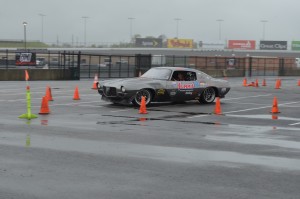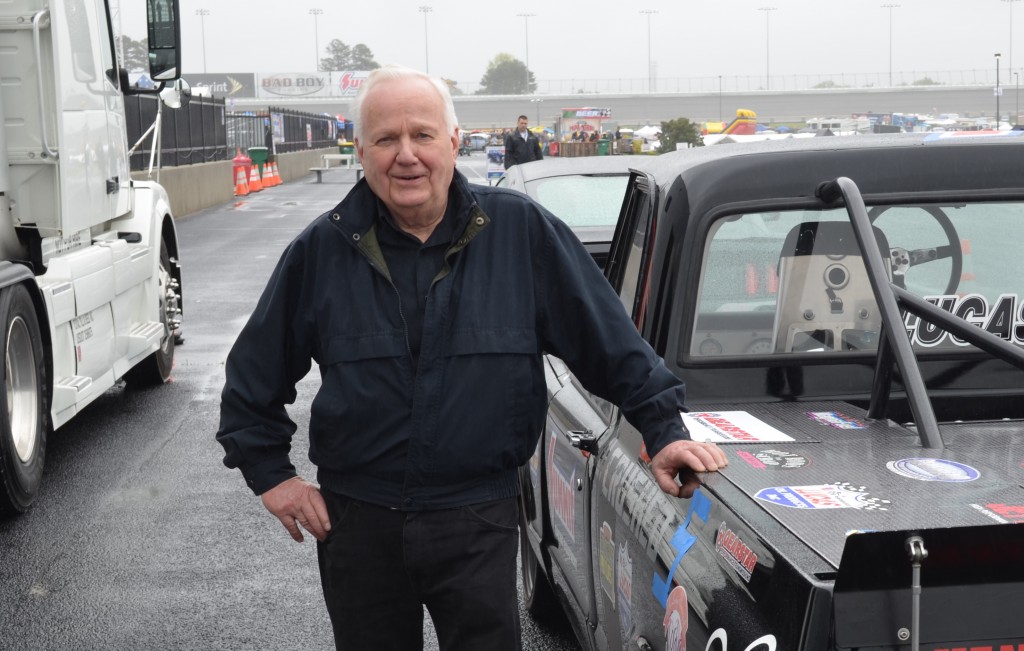Warren Johnson is drag racing legend.
During the 1990s, “the Professor” dominated the NHRA’s Pro Stock class, winning six world championships en route to 97 career wins. He was also the first driver to take a Pro Stock car past the 180-, 190-, and 200-miles-per-hour marks.

The Crusher Camaro, owned by Dave and Karen Leisinger, features an 800-horsepower, Johnson Racing-built V8.
In recent years, Johnson has scaled back his NHRA appearances, but he still keeps busy doing what he loves best—building and tuning engines. In fact, Johnson has taken his legendary engine building and development skills to the twists and turns of the autocross. You’ll find Johnson Racing-built motors inside two of the more formidable autocross cars: the Summit Racing-sponsored Crusher Camaro and Crusher II Corvette.
Owned and driven by the Leisinger family, Crusher and Crusher II have dominated at autocross competitions at the Goodguys shows, Holley’s LS Fest, and other events. We caught up with Warren Johnson as he watched the Leisingers compete at the Summit Racing Equipment Atlanta Motorama. Although he’s taken his talents to the autocross, he still says he’s got what it takes to get back in the mix in NHRA Pro Stock.
OnAllCylinders: Have long have you been racing in NHRA?
Warren Johnson: I started full time in 1976. So that makes 38 years.
OAC: Do you have plans for racing Pro Stock in 2015?
Johnson: We may attend some races later on this year. We’ve got project stuff like (these autocross engines) that we’ve got to get out of the shop. When I get time to do some more development work, we may go out later this year. We’re not intending on pursuing a championship this year, but if we find enough financial backing we could probably pursue another championship in the future. I feel we could be competitive. We’ve done it before; it’s nothing new.
OAC: Do you miss drag racing or are you too busy to think about it?
Johnson: I miss the mechanical end of it. That’s always been my forte—the development of the cars and engines. The driving part of it? Like I’ve said before, when I started racing (son) Kurt was too young, (wife) Arlene didn’t want to drive, and the dog couldn’t get a license. So I had to drive.
OAC: You’ve been so involved in Pro Stock engine development. How much more power do you think can be made with the current Pro Stock rules?
Johnson: If the rules remain the same, the only area you’ll gain power from is different materials, which in the last 10 years, is really what has allowed Pro Stock engines to get where there at today. Better valve spring material, piston/rod materials, and so forth—all that has allowed them to run higher rpm reliably. That’s where the performance has come in. I don’t see a whole lot more (power) unless the rules change. Maybe two or three percent more power total.
OAC: How long have you been involved in autocrossing?
Johnson: About three years.
OAC: How did you get involved?
Johnson: Through a mutual friend in Minnesota that knew the Leisingers. They needed an engine built, and they knew that’s what we basically did. I just asked them what the characteristic of the engine should be. I knew about autocrossing but I never watched it. So I took my best guess of what the characteristics of the engine should be and they put it in there. And they’ve amazed themselves.
OAC: How does autocross competition stack up to Pro Stock racing?
Johnson: They’re a universe apart. This involves right and left and acceleration/deceleration, so it’s more of a true test of a real car, where Pro Stock is just acceleration—at least that’s what it’s supposed to be. But I like all forms of motorsports. I watch NASCAR stuff, Sprint Car, Formula 1—it doesn’t make any difference to me. As long as it goes putt-putt and smells bad, I’ll watch it.
OAC: How does putting together an autocross motor differ from building a Pro Stock engines?
Johnson: Because the requirements are slightly different, there’s a difference in building the two engines. Because the application is different, there are things that you do with a Pro Stock motor that has absolutely no application out here. Just like a circle track engine—the only difference between a circle track and a drag race motor is thermal management, which you’ve got out here because of extended running times. So yeah, there are different charcteristics to these engines, like the fact that they don’t have the type of traction we have in Pro Stock. You have to have a different rpm and power curve.
OAC: Any plans to retire?
Johnson: How do you spell that? If have fun doing what you’re doing, why would you want to retire?


Warren, if your captors let you read this: remember “Zora Duntov?” He’s the “Man From Hong Kong,” isn’t he? JigSaw sang the huge profitmaking film in the 80’s , even now on 2 hour free You Tube classic films. He was Bruce Lee, in disguise, but, Warren, since then, my OnStar reads me the newspaper, but still won’t listen… Please, we need 600 horsepower in my Lexus tractor, but not the hybrids, if you get my gist?…Sincerely, Michael Gorchovphv
I’d love to see your expertise in the ProMod arena… This class is exciting to watch. Too bad NHRA doesn’t embrace it like the fans do.